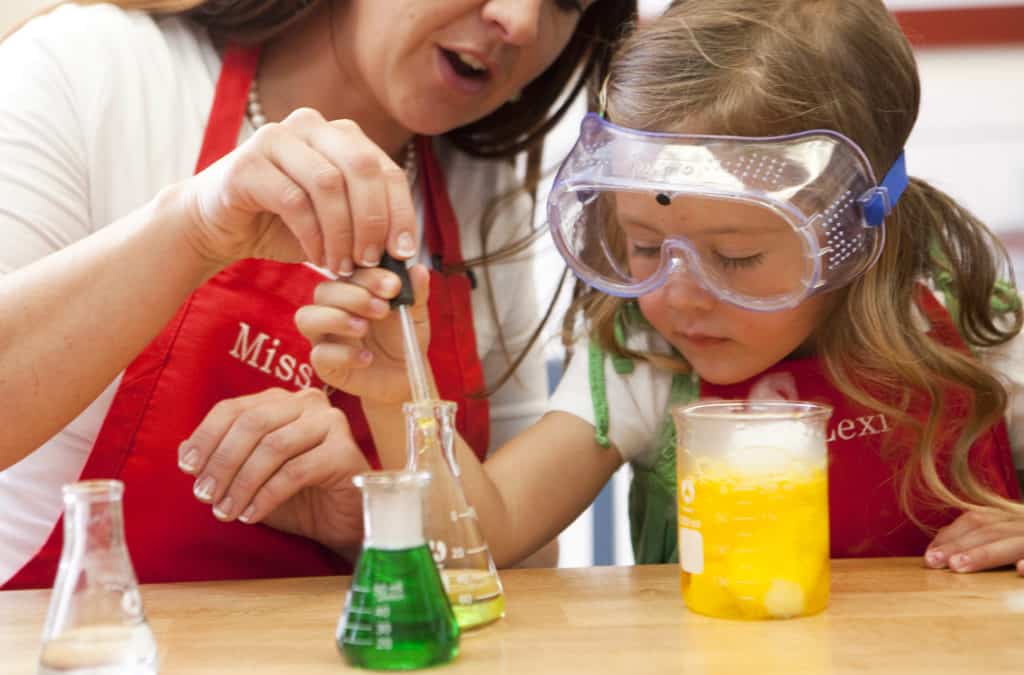Chocolate eggs, marshmallow chicks, and cookies galore! We love sweet holiday treats as much as the next kid, but here at Kids Village we “spring” at the opportunity to include a touch of learning (and a lot of fun) into our holidays.
With the festivities of spring and Easter hopping through our school, we’ve put together a list of our favorite STEM (science, technology, engineering, and mathematics) Easter experiments for your whole family:
Easter Egg Drop
Sure, deviled eggs and egg salad are a great way to use your decorated eggs after the hunt is over, but why not set a few aside for this fun STEM Easter activity?
You probably remember that day in high school physics when you and your friends looped straws and tape around an egg to prevent it from breaking when you dropped it off a ladder. With a few minor adjustments, this activity can be a fun for kids of all ages.
For older children, let them come up with their own list of materials to protect their egg from a drop (have a responsible adult drop the egg from a safe location or make sure to have plenty of parental supervision to prevent falls).
With younger children, a great alternative is to get some gallon-sized ziplocs and fill the bags with different materials (such as flour, cereal, paper towels, plastic cups, water, etc.) and see which materials prevent the egg from cracking when it’s dropped. Make sure to let your kid make predictions, then talk about why they think it worked or didn’t work.
To see this activity in action and to download some free printables, visit: http://buggyandbuddy.com/stem-kids-egg-drop-project/ (older kids) http://littlebinsforlittlehands.com/egg-drop-activity-stem-challenge-young-kids/ (young child alternative)
Sink of Float?
Before you toss your leftover plastic Easter eggs in the recycling bin, try this fun and simple Easter experiment:
Fill a bowl full of water, and gather a variety of items from around the home with which you can fill plastic eggs (for example, coins, dry beans, rice, mini marshmallows, peeps, rocks, beads, etc).
Ask your child to put an empty plastic egg in the water to see if it sinks or floats: this is your “control egg.”
Next, have your child help you fill each egg with a different material. Hypothesize whether each egg will sink or float in the water, then test it out! Talk to your child about what makes different items float versus sink.
Sparkly Bunnies
With a few simple ingredients (and the help of a responsible adult), children can use pipe cleaners and a chemical reaction to form some sparkly crystal Easter bunnies overnight. If you have an older child, challenge him or her to come up with some variations of the experiment to test along side the original formula to see what changes might occur.
Find instructions for this fun science experiment here: http://creeksidelearning.com/cool-science-experiments-growing-crystals/
Peeps Catapult
Even though Peeps seem to be an Easter staple, not everyone likes the way they taste… But using them as a projectile in an engineering experiment is something kids and adults alike can enjoy!
All it takes is ten pencils, a handful of rubber bands, a plastic spoon, and an arsenal of fluffy peeps. This particular catapult is a mangonel that uses tension from stretched rubber bands to launch peeps into the air.
Do you have an older child? Challenge them to come up with some alternate peep-catapulting designs of their own.
For instructions on how to build this fun contraption, visit: http://www.playdoughtoplato.com/peep-catapults/
Egg-xcellent Easter Experiments
You have probably already tried the disappearing eggshell trick using a raw egg and vinegar, but Momma’s Fun World combines this experiment into a trio of experiments to disappear an egg shell, shrink the egg, and then make the egg erupt. All the ingredients are simple and open up some fun science dialogue with your child: http://mommasfunworld.blogspot.com/2013/03/3-egg-science-experiments.html?m=1
Walking on Eggs
If you’re like us, you stock up on eggs for dyeing, hiding, and hunting during Easter. Before you start boiling those eggs, take the opportunity to try this fun walking on eggs experiment! This experiment includes, very simply, standing on eggs without them breaking.
How does it work? The shape of an egg is similar to a three-dimensional arch, which is one of the strongest architectural forms. With an even distribution of weight, eggs can withstand a remarkable amount of pressure.
Find tips on how to best conduct this experiment and the mechanics behind why it works here: http://www.stevespanglerscience.com/lab/experiments/walking-on-eggshells/

